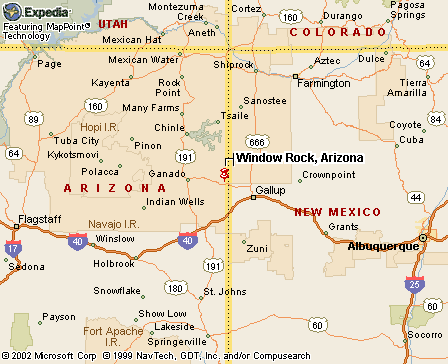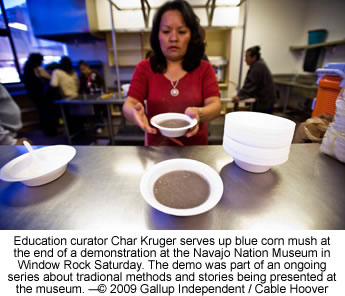 |
Canku Ota
|
 |
|
(Many Paths)
|
||
|
An Online Newsletter
Celebrating Native America
|
||
|
February 1, 2009 - Volume
7 Number 2
|
||
|
|
||
|
Diné Fare
For Blue Corn Mush, Technique Is Everything |
||
|
by Karen Francis - Diné
Bureau, Gallup Independent
|
||
|
On Saturday, Kruger gave a presentation on how to make blue corn mush at the Navajo Nation Museum as part of activities to encourage cultural teachings. Blue corn mush is a traditional Navajo food. Kruger said this is the perfect time to teach how to make it because it is a healing food. Ella Silversmith, fromTohlakai, never learned how to make blue corn mush when she was growing up, so she came to learn how to make it. “We got the cedar ash. The only thing we need is the corn meal,” she said. She prefers to eat blue corn mush with a little sugar added, she said as she sampled the mush that Kruger handed out after the demonstration was finished. But Joe Silversmith said he prefers his with a little salt added. “Try it both ways. See which one you like,” he said. For Silversmith, blue corn mush is a treat that he would have to go to the flea market to enjoy. “Now I don’t have to go to the flea market to buy this,” he said. He used to know how to make it from watching his grandmother but he forgot over the years and came to refresh his memory. “I knew the ingredients. It’s just putting it together,” he said. Diana DeChilly, from Fort Defiance, had made blue corn mush before and learned some tips as she watched. “Mine came out lumpy because I didn’t use cold water,” she said. DeChilly said she came to the presentation because she was given a lot of corn meal when her nephew got married. She was planning on going home and trying her hand at it again. She is also interested in learning how to make blue corn pancakes one day. “I learned about these cooking sticks. I think I’m getting a cooking stick. It seems easier than using a whisk,” she said. Corn meal and cedar ash are the two main ingredients in the traditional food. “This is a very important ingredient to the mush,” Kruger said about the cedar ash. One audience member said that if the cedar ash is not used, it will taste bitter. Kruger first showed the audience some of the traditional items that were used in making blue corn mush, such as a grinding stone and a brush made out of plants. Now, corn meal can be bought at the store already ground and cedar ash can be purchased at the flea market. After talking about the traditional process, she took the audience into the kitchen and went through the steps of making blue corn mush that she learned from her grandmother. “We always say we’re from different parts of the reservation. What I’m sharing with you today is what my grandma taught me,” she said. To cook the mush, a pot of water is put on to boil. A bowl of cold water is filled and a spoonful of cedar ash is added for taste and color. After she added the cedar ash, Kruger stirred the mixture with the stirring stick. Corn meal is then stirred into the mixture a small handful at a time with the stirring stick. It is also a good idea to roast the corn meal if it isn’t before adding. Some audience members said they prefer to roast the corn meal even if it comes already roasted. After the pot of water is boiling, the bowl with the mixture in it is slowly added. More corn meal is added by the handful as needed for preferred consistency. The mush is stirred constantly as it cooks for 10 to 15 minutes. Kruger, museum education curator, said she is planning to do another demonstration on how to make blue corn bread but a date hasn’t been set. As the new education curator, she is trying to hold cultural activities every month. Other activities at the museum this month include Coyote storytelling — in Navajo only — by Julia Westley at 1 p.m. on Tuesday, humor stories told by Larson Manuelito at 10:30 a.m. on Jan. 20, and poster star constellation by Robert Johnson at 11:30 a.m. on Jan. 27. |
 Window Rock, Arizona map |
www.expedia.com |
|
|
||
|
|
||
| Canku Ota is a free Newsletter celebrating Native America, its traditions and accomplishments . We do not provide subscriber or visitor names to anyone. Some articles presented in Canku Ota may contain copyright material. We have received appropriate permissions for republishing any articles. Material appearing here is distributed without profit or monetary gain to those who have expressed an interest. This is in accordance with Title 17 U.S.C. Section 107. | ||
|
Canku Ota is a copyright ©
2000, 2001, 2002, 2003, 2004, 2005, 2006, 2007, 2008, 2009 of Vicki
Barry and Paul Barry.
|
||
 |
 |
|
|
The "Canku
Ota - A Newsletter Celebrating Native America" web site and
its design is the
|
||
|
Copyright ©
1999, 2000, 2001, 2002, 2003, 2004, 2005,
2006, 2007, 2008 of Paul C.
Barry.
|
||
|
All Rights Reserved.
|
||
 WINDOW
ROCK — As Char Kruger slowly adds corn meal to the blue corn
mush on the stove, stirring it clockwise, people begin asking questions.
Should they roast corn meal before making the blue corn mush? Do
they add sugar? How long should it cook?
WINDOW
ROCK — As Char Kruger slowly adds corn meal to the blue corn
mush on the stove, stirring it clockwise, people begin asking questions.
Should they roast corn meal before making the blue corn mush? Do
they add sugar? How long should it cook?